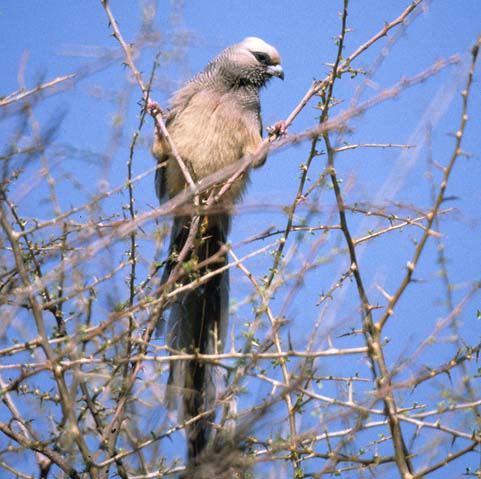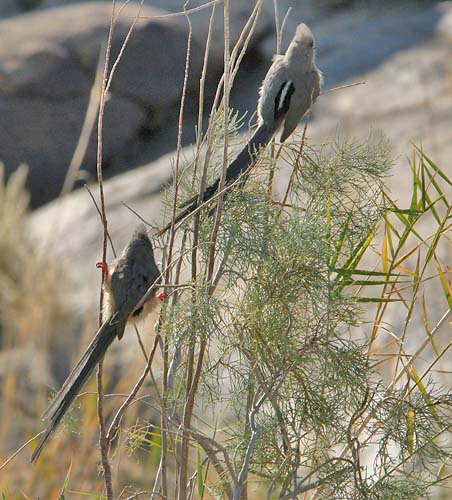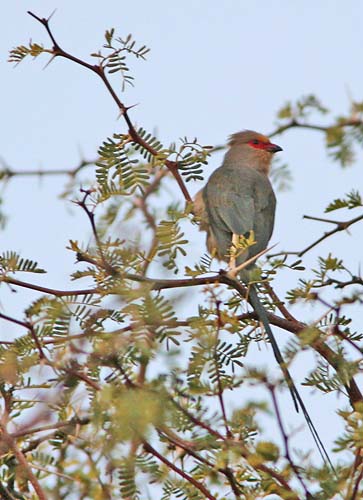
a web page by Don Roberson |
MOUSEBIRDS Coliidae |
||
|
||
There are only two genera among the mousebirds, and four of the six species are placed in Colius, including White-headed Mousebird of east Africa (left). White-headed Mousebird, like most of this genus, is a bird of arid thornscrub. Its range is limited to a band of such thornscrub from s. Somalia to n.e. Tanzania. The most widespread species, Speckled Mousebird C. striatus, occurs more broadly in a variety of woodlands. The four species of Colius mousebirds are essentially allopatric in distribution, without any significant overlap, and where there is a little range overlap, they separate out by habitat. |
||
Mousebirds eat a lot of fruit — these Blue-naped Mousebirds were at a fruiting tree — but they also eat a wide variety of plant material, including leaves and stems, including some plants that are toxic to other animals. While native fruits remain a major part of the diet, they will also eat fruit from ornamental non-native plants (de Juana 2001). |
||
 White-backed Mousebird
(left) is restricted to southwestern Africa: Namibia to western
Botswana and South Africa. Like all mousebirds it has a long, graduated
tail, and a crest — this crest a bit more prominent than some other
species. This photo also shows one unusual character of the family: the
habit of perching with the body vertically suspended between the widely
splayed feet, held apart at chest level (de Juana 2001). White-backed Mousebird
(left) is restricted to southwestern Africa: Namibia to western
Botswana and South Africa. Like all mousebirds it has a long, graduated
tail, and a crest — this crest a bit more prominent than some other
species. This photo also shows one unusual character of the family: the
habit of perching with the body vertically suspended between the widely
splayed feet, held apart at chest level (de Juana 2001). |
||
Mousebirds are very social, and are almost always found in small family parties. Part of a small flock of White-backed Mousebirds is shown below left. You can also see the distinctive (but narrow) white patch-on-the-back pattern of the upper bird. One apparent reason for the flocking behavior is that mousebirds seem to have inadequate thermal control, and they huddle closely together in cold periods and to sleep, jostling for the warmest, centermost position (de Juana 2001). While Colius mousebirds do not overlap in distribution, there are many places where there is one species of Colius and a species of Urocolius mousebird. Southwestern Africa is one of those, with the latter genus represented there by Red-faced Mousebird (below right). |
||
|
||
All six species of mousebird appear to be doing well — not a single species is currently thought to be declining in range or numbers (de Juana 2001). The most local species is Red-backed Mousebird Colius castanotus of Angola, but where it occurs it is said to be common. Mousebirds have adapted to man-made habitats, and are even considered a 'pest' in some places because they eat so much fruit. Yet they are totally unique birds — truly unrelated to anything else alive today — and thus a treat on any African safari. |
||
Photos: The White-headed Mousebird Colius leucocephalus was in Amboselli NP, Kenya, in Nov 1981. The Blue-naped Mousebird Urocolius macrourus leucocephalus was at Lake Baringo in Nov 1981. The White-backed Mousebird Colius colius was at West Coast NP, South Africa, on 5 July 2005, and the photo of two of a flock of this species was at Augrabes NP, South Africa, a couple of days later. The Red-faced Mousebird Urocolius indicus was at Canyon Lodge in southern Namibia on 14 July 2005. Photos © Don Roberson; all rights reserved. Bibliographic note: There is no "family book" per se, but a good introduction to this family, with some excellent photos, is in de Juana (2001). Literature cited:
|
 Mousebirds,
sometimes called colies, are an ancient group of small arboreal birds
in Africa. They are so unique in morphological peculiarities that they
were proposed as a separate Order of birds as long ago as 1872, and
this placement has been confirmed by molecular evidence (Sibley &
Ahlquist 1990, Hackett et al. 2008). They are the only Order restricted
to sub-Saharan Africa.
Mousebirds,
sometimes called colies, are an ancient group of small arboreal birds
in Africa. They are so unique in morphological peculiarities that they
were proposed as a separate Order of birds as long ago as 1872, and
this placement has been confirmed by molecular evidence (Sibley &
Ahlquist 1990, Hackett et al. 2008). They are the only Order restricted
to sub-Saharan Africa. Two species of mousebird are assigned to genus Urocolius, including Blue-naped Mousebird
(right), a species of dry scrub south of the Sahara. This species has a
red facial mask, with the blue nape rather hard to see (but it is
visible on the bird in the back). The skeletons of the two genera are
different, and Urocolius mousebirds are stronger fliers, while Colius mousebirds spend most of their time 'creeping' through the vegetation, like small rodents, giving rise to their family name.
Two species of mousebird are assigned to genus Urocolius, including Blue-naped Mousebird
(right), a species of dry scrub south of the Sahara. This species has a
red facial mask, with the blue nape rather hard to see (but it is
visible on the bird in the back). The skeletons of the two genera are
different, and Urocolius mousebirds are stronger fliers, while Colius mousebirds spend most of their time 'creeping' through the vegetation, like small rodents, giving rise to their family name.
